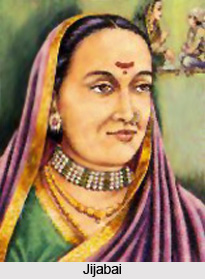 Jijabai, the mother of Shivaji, has been one of the strongest influences on the great Maratha leader. She was the only person in his life whom he whole-heartedly respected and had and unwavering loyalty towards. She was a great source of inspiration for Shivaji and was responsible for cultivating the spirit of bravery and humanism in him. She helped young Shivaji to dream of an independent Maharashtra and inculcated in him the spirit of tolerance, justice and fair play. By far the greatest influence in Shivaji`s life, his guardian deity and protector was also a woman. She is known to have made rare but extremely enlightening appearances to the great Maratha leader.
Jijabai, the mother of Shivaji, has been one of the strongest influences on the great Maratha leader. She was the only person in his life whom he whole-heartedly respected and had and unwavering loyalty towards. She was a great source of inspiration for Shivaji and was responsible for cultivating the spirit of bravery and humanism in him. She helped young Shivaji to dream of an independent Maharashtra and inculcated in him the spirit of tolerance, justice and fair play. By far the greatest influence in Shivaji`s life, his guardian deity and protector was also a woman. She is known to have made rare but extremely enlightening appearances to the great Maratha leader.
Born the daughter of a Hindu chieftain, in the town of Sindhkhed in Maharashtra in 1594, she grew up amidst the splendour of a Muslim court. Her father was Lakhuji Jadhav Rao, a descendant of the Yadava kings of Devagiri and a powerful Sardar at the court of Nizam Shah of Ahmednagar and her mother was Malasa Bai. She developed considerable strength of character herself, though of course in a limited way. She was married to Shahaji Bhonsle, a Maratha chieftain and the son of Maioji. Shahaji Bhonsle received the jagir of Poona and Supa from Nizam Shah and the fortress of Shivneri and Chakan. Her greatest attribute was that she accepted the tribulations that came to her after marriage with stoic calm. She chose not to change her destiny for the easier life which her father offered her, preferring to stay on in the rugged forts at her mobile husband`s bidding rather than return to her former softer life of ease and comfort.
Soon she realised there would be no stability in her life with Shahaji for he was so constantly on the move, sometimes pursuing, sometimes being pursued. Her first born Sambhaji was taken away from her in the routine manner of a Hindu chieftain`s son. Her second son, Shivaji, remained with her. He was a stubborn though high-principled boy with a mind of his own, and with objectives which he relentlessly pursued. Shivaji shared one characteristic with his mother, which was the inability to compromise. This inherited trait was part of his strength of character and it remained with him throughout his life. It also endeared him to his mother who, unable to understand all the nuances of human nature, could easily appreciate and respect this indomitable quality in her son.
There was one other quality she had, a deep and abiding faith in her religion such as many Hindu women of the older generation had. But Jijabai had the added advantage of being able to live close to one who went out to defend that same religion at a time when a superior alien force was desecrating the temples in which her people prayed. That drew Jijabai closer to Shivaji than would have been the case had he been only a successful fighting soldier. Shivaji`s battles, in the context of his several pronouncements, had all the marks of a crusade. When, early in his life Shahaji tried to mould the young Shivaji to the way of life lived in the Sultan of Bijapur`s court, the lad resented it, and it was because of Jijabai`s influence over Shivaji that he was able to understand the reason for his resentment. Again, when Shivaji needed to think aloud and ponder on what he was fighting for, it was during the hours he spent talking to his mother that he attained a true understanding of his crusade which he may otherwise have lacked. Thus his mother became associated with the most important phases of his life and because of her implicit, almost blind faith in Shivaji she constantly provided the understanding and encouragement that he needed. She was his audience for the expression of his most secret thoughts.
At Shivaji`s coronation, she officially became the first lady of his empire though even in the days before the ceremonial she was regarded as the most important woman in Maharashtra. His wives were of course there with places of honour reserved for them, but according to the custom of all religions in India, age takes precedence over titles, honours and almost everything else. So no one grudged her the position Shivaji gave her; no one would dare challenge it in any case. For Shivaji, Jijabai ranked higher than any Sultan or general. At times she took precedence over Shivaji himself for that was how he wanted it to be. She was friend, guide, philosopher, not only to Shivaji, but to the whole movement before and after it gathered momentum.
After Shivaji was crowned, and even before all the festivities were over, Jijabai passed away in their Raigarh home.



















